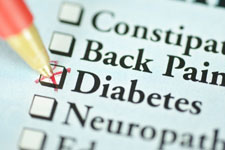 What is type 1 diabetes? This type of diabetes is when your pancreas no longer produces any insulin. Insulin is the hormone that is needed by your cells to convert glucose, or blood sugar, to energy that your cells need to run properly. If you cannot process the glucose, then the glucose builds up in your blood causing high blood sugar.
What is type 1 diabetes? This type of diabetes is when your pancreas no longer produces any insulin. Insulin is the hormone that is needed by your cells to convert glucose, or blood sugar, to energy that your cells need to run properly. If you cannot process the glucose, then the glucose builds up in your blood causing high blood sugar.
If insulin is not injected, then the high blood sugar levels can lead to a diabetic coma, and ultimately death. However, despite this frightening outcome, it usually doesn’t come to this. More typically, type 1 diabetics learn to control their insulin levels or obtain medical care when necessary.
Traditionally, type 1 was most common in children and young adult. However, during the last several decades, type 1 has risen in prevalence not only in younger populations, but in older adults, as well. The condition is equally prevalent in males and females, but more prevalent in whites than non-whites.
Type 1 is characterized as an autoimmune disease. An auto immune disease occurs when the body’s immune system attacks another part of the body. In type 1, the immune system attacks and destroys the insulin producing cells in the pancreas (specifically known as the islets of langerhans). As little or no insulin is produced, a type 1 diabetic must take insulin daily.
10 Percent of Cases. Type 1 accounts for 5-10% of all diabetes cases. Former terms for type 1 include: child onset diabetes, juvenile diabetes, insulin dependent diabetes mellitus (IDDM).
Symptoms and Characteristics
-
Causes: Scientists have not determined any definitive cause for type 1 diabetes. Various autoimmune, genetic and environmental factors are often cited as being the precursor to the disease. Some scientist theorize that type 1 may be triggered by some form of viral infection, others think differently. Learn more about what may be the causes of type 1 diabetes.
-
Symptoms: Typically, type 1 symptoms develop over a very short period of time (weeks to months). However, certain cellular destruction can be occurring for years. The typical symptoms include: increased thirst, increased urination, increased hunger, weight loss, blurred vision, fatigue. Insidiously, many of the symptoms are also very common for other maladies, so please keep this in mind and read further.
-
How Insulin Helps Transfer Glucose: Sometime looking at the “big picture, we forget about what insulin is and what it does. This article gives a clear basic overview of how insulin helps transfer glucose into our cells, thus delivering needed energy. We also look at what happens when this process breaks down.
Diagnosis and Complications
-
Diagnosis: While the symptoms can be common, diagnosis is critical as early as possible. But, how exactly is this done? There are three different blood tests recommended by the American Diabetes Association. We look at each one in turn and let you know what the numbers mean.
-
Ketoacidosis: Whether you weren’t diagnosed in time or your diabetes got away from you, a condition called ketoacidosis can occur. This is bad. Effectively, this is coma where you pass out due to the large increase in ketones in your blood. If you have no idea what I am talking about here, please read the article. Your life, or the life of a love one may depend upon it!
-
Complications: Like many things in life, there always seems to be the possibility of complications. Diabetes is no different. Even well managed diabetes can lead to complications. This page looks at the most common problems, why they occur and what to do about them. Whether it’s your kidneys, nerves, eyes or heart you will want to check these out.
Interesting Tidbits
-
Treatment: Once you know you have diabetes, the next step is to treat it. This page provides a brief overview of treatment options with a small emphasis on natural or alternative healing methods.If you haven’t meditated, heard about ayurvedic medicine or taken nutritional supplements, you will want to learn about some of these subjects to talk with your doctor about.
-
Who Discovered Diabetes? I love history. I was fascinated to learn that some of the earliest references about diabetes date back to 400 B.C. This is a fascinating look back in time to the origins of the condition. It also takes an extensive look at how modern treatment methods evolved so that diabetes is no longer a death sentence.
-
Statistics: If you are curious about how many other people are affected by type 1 diabetes, we break down the latest facts and figures here. We throw in a good dose of type 2 stats for comparison as well.
Other Related Conditions
-
Brittle Diabetes: Several conditions are somewhat related to type 1 diabetes and go by similar names. One condition called brittle diabetes is very rare, but can affect some people with type 1 who have difficulty managing their condition.Brittle diabetes is often confused with other conditions and the symptoms can be fairly innocuous. If you have type 1 diabetes and are having problems, take a look at this article.
-
Diabetes Insipidus: Curiously, diabetes insipidous isn’t even diabetes!! However, it does share one key symptom with its more famous namesakes. See if you can guess based on the picture.By
SOURCE:
National Institute of Health Publication No. 09-3873, Diabetes Overview, Updated April 2012, (accessed February 2013).
National Institute of Health Publication No. 11-3892, National Diabetes Statistics 2011, Updated December 2011 (accessed February 2013).
Center for Disease Control, cdc.gov, Diabetes Frequently Asked Questions (accessed December 2008).
Erich Schultz – Last Reviewed February 2013.











